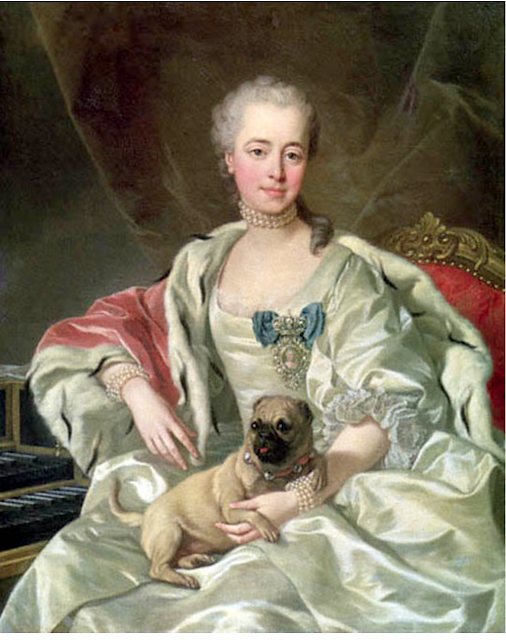Post a Pup Sundays! Historical Royal Dog Lovers
Throughout history, many royals have found solace and companionship in the company of their furry friends. For instance, Henry III of France cherished his bichons and spaniels so much that he carried them in a little basket around his neck. Similarly, Queen Victoria created a pet cemetery with epitaphs to honor her beloved pets. German-born Elizabeth Charlotte, Duchess of Orleans, once wrote from the Palace of Versailles, "Dogs are the best people I have come across in France," highlighting the unique bond humans can share with their four-legged companions.
Alexander the Great is known for being an almost unstoppable conquerer. Legend has it that his beloved dog Peritas was a gift from a Greek King. Legend also states that Peritas had taken down a lion and an elephant. Peritas was Alexander's companion in life and in battle. When Peritas died, Alexander named a city, believed to be somewhere in India, after him. Records do not indicate what breed Peritas was, but it is thought he was a Mastiff or a Greyhound.
Mary, Queen of Scots, loved animals in her subjects and pets since childhood. She was brought up in the French royal family's warm and loving nursery, surrounded by many pets, including "four big dogs and twenty-two little lap dogs," according to historian Antonia Fraser.
Even after returning to Scotland in 1561, Mary's love for animals, especially dogs, remained. According to Fraser, she adored both small dogs and great hounds of the chase. Her inventories contained pretty blue velvet collars for her little dogs and allotted two loaves of bread daily. Payment was made to the boys who looked after them, and sometimes, they were sent to France.
During her tedious and lonely years of imprisonment in England, Mary's pets became even more important to her as companions and support animals. She kept caged birds like turtle doves and Barbary fowls and doted on her tiny lap dogs. After her execution in 1587 in the cold Great Hall of Fotheringhay Castle, her executioners discovered that her most devoted friend had stayed with her until the very end.
 |
| The story of a loyal Skye Terrier: Greyfriars Bobby. |
Her little lap dog, a Skye Terrier, who had managed to accompany her into the hall under her long skirts, where her servants had been turned away, had now crept out from beneath her petticoat and, in its distress, had stationed itself piteously beneath the severed head and the shoulders of the body. Nor would it be coaxed away but steadfastly and uncomprehendingly clung to the solitary thing it could find in the hall, which still reminded it of its dead mistress.
Charles II of England was known as the "Merry Monarch," he loved to be amused. Besides women, nothing amused him more than his beloved dogs. At age five, he was first pictured with a little spaniel in a Van Dyck painting. His love for these small dogs became so famous that a breed was eventually named after him - the Cavalier King Charles spaniel.
 |
| Young Charles and the beloved spaniel breed. |
After ascending the throne in 1660, the king often brought his dogs to council meetings, which annoyed the famous diarist Samuel Pepys. Pepys once wrote about a trip to Whitehall in 1667, "All I observed there is the silliness of the king, playing with his dog all the while, and not minding the business." However, some people were more amused by the king's behavior. Lord Rochester even composed a ditty about it: "His very dog at council board / Sits grave and wise as any lord."
Catherine, the Russian monarch, was an avid pet lover, but Zemira held a special place in her heart amongst all her dogs. Zemira, a dainty greyhound, was named after the Beauty and the Beast opera characters Zemira and Azor. She was a constant companion to Catherine and slept in a pink silk-lined cradle in her mistress's room. Zemira would also join Catherine on her daily walks.
Catherine was so fond of Zemira that when she commissioned the artist Vladimir Lukich Borovikovsky to paint her portrait in 1794, she chose to be depicted walking in the park with Zemira. Although Zemira had passed away almost a decade earlier, art historians believe that the painting is a posthumous dog portrait rather than a portrait of one of Catherine's dogs at the time. Furthermore, there are other sculptures and porcelain pieces of Zemira, a testament to Catherine's deep affection for her beloved dog.
When Zemira died, Catherine was devastated. She withdrew from public life and shut herself in her room for days. Zemira was laid to rest in Catherine's pet cemetery, buried under the most prominent tombstone, which bore the inscription "Beloved dog of the Great Queen."











Comments
Post a Comment